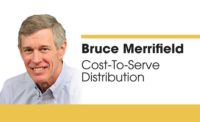Measure your vital intangibles

The law dictates you must be able to show financial numbers based on things that are easy to see, count, tax and borrow against.
Because financial numbers are ultimately downstream, aggregated symptoms or byproducts of your business activity, you won’t find any powerful insights within them or their sliced and diced derivatives.
Most distributors keep their vital signs in order with a well-worn set of practices, including leadership, strategy, competent and committed people who are empowered, best service value, operational effectiveness and incentive schemes (for sales reps).
Other vitals, though not typically mentioned, are a high-performance culture, high innovation capability, continuous learning, customer-profitability metrics and customer-centricity. These are the intangible vital signs, the keys to success. So why not measure these? Here are a few reasons why most companies don’t measure vital intangibles and some short answers on why you should.
Reason: I wouldn’t know how to begin to measure these.
Answers: The first step is to break the vague idea into specific observable attributes. Assign ballpark values and start with simple prototyping of your models. Don’t strive for certainty, which is unachievable. Instead, seek to reduce uncertainty in order to make statistically better decisions. Also, you can research how the best companies are measuring VIs. Google “How to measure ‘X’” and you’ll see plenty of case studies to get you started.
Reason: We don’t have the money or talent to do these models.
Answers: Start simple and small. Do a little investigation. Try a few calculations. Build a simple model. Discuss. Tweak it some more. If you can increase your odds of making better decisions by 20%, why not?
For example, A VP of sales might only work with the top 20% reps calling on the top 5% high-profit-improvement accounts. Won’t the return on calls be greater than democratically calling on milk-run accounts with weaker reps who don’t follow through on honcho-uncovered opportunities?
Reason: Ranking reps or branch managers by some total value number could be contentious.
Answers: Rank them without names. With permission from the best, you might reveal who they are only if they commit to sharing their best practices to others. You can confront the low performers in private and solve performance gaps.
Too many dashboard numbers are financial output numbers. Why not start measuring controllable, input actions focused on improving VIs? For example, for this past month how many honcho calls were made on the top 5% biggest profit-improvement-potential accounts with competent follow-up resources? Now that’s a number that matters for the present and future of your company.
High credit-activity customers
How do you measurably increase a customer’s value, keep and win more share of their business, and improve the net profitability of the account? A first step should be to purge the bad habits underlying high credit-activity customers. First, you must be capable of looking at customer profitability on every line item. You can design this capability to do many things, including spotlighting the cost of credits. Here are three ways:
-
Credits/thousand-line-items-bought for each customer;
-
Cost of credits involving returns or price adjustments; and
-
Cost of orders in which goods were sold below cost (closeouts, inventory deflation).
With this data, you can focus on the 5% of customers with outrageously high credit-cost activity. A simple scanning of their credits can reveal the root causes for unnecessary costs to both parties. Diplomatically presenting solutions and cures can then generate mutual savings, more share and more profits.
In looking at some 2016 numbers from various distributors ranging from $100 million to $2.5 billion in sales, most of these companies have some customers racking up tens to hundreds of thousands of dollars of credit-activity costs.
We can conclude distributors with active counters for contractors tend to have more returned goods if they allow returns without restocking charges. But in all the cases presented, opportunities were found with the few customers with high credit costs. In all cases, the majority of similar customers were able to buy what they wanted acceptable or no credit costs.
What’s behind the big credit totals? It’s often either myopic thinking or a legacy of bad habits. High-credit customers often are simply doing what they have always done and may not recognize the issue. For example, a distributor with credit costs 260% of operating profits has some retail customers that systematically return slow-moving small-dollar items to improve inventory turns. This is silo-metric myopia. Most customers realize the costs for returns exceed the cost of lower turns and they use more effective system measures.
In contrast, a distributor with credit costs 3% of operating profits also sells to retailers, but its upfront return policies prevent unnecessary lose-lose activities from slack customers.
Looking for a reprint of this article?
From high-res PDFs to custom plaques, order your copy today!




